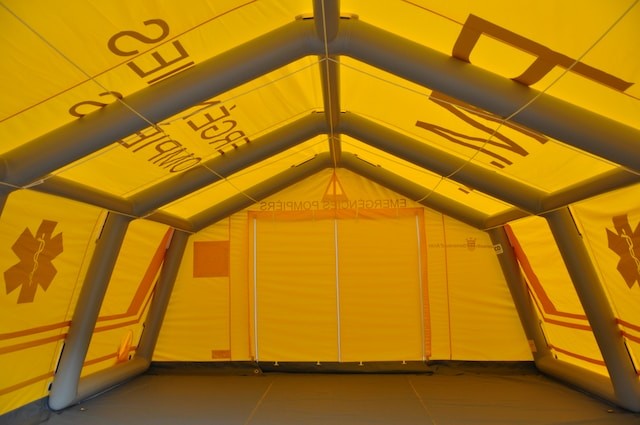Now thousands of people are arriving in Armenia, forced to leave their homes in Artsakh. To accommodate them, you will need camps and shelters. But it is not enough to find a territory for temporary migrants, it is important to organize work on it, to build a system.
To ensure that a minimum of mistakes are made when organizing camps in Armenia, we talked with 10 organizers of temporary stay centers for refugees, volunteers helping people in different countries, and shared their experiences.
Contents
Main rules
“Camps are temporary structures built to provide immediate protection and assistance to people forced to flee.” (United Nations High Commissioner for Refugees). It is important that the camp is a transit place where people do not stay for more than one to three months, otherwise the motivation to move on disappears, psychological problems, apathy arise, the desire to move, to leave disappears, and besides, the dependent position puts pressure on refugees. It is necessary to explain that the camp is not forever.
Now let’s understand how a camp should be set up: what and how to place it.
Experienced volunteers say that the camp should not be in a field. It is desirable that there be a populated area nearby where temporary migrants could quickly get to and not remain far from civilization. If public transport does not go through the camp, it is necessary to organize a transfer to the nearest cities, the capital and other camps where refugees are likely to be distributed. Volunteers should be prepared to provide information about transportation and infrastructure.
Transport must be able to drive up not only to the meeting area, but also to the food warehouse so that it can be conveniently unloaded, as well as to the medical tents to deliver medicines, equipment and take people to the hospital.
The camp must have electricity, water, heating and communications, or at least the ability to quickly connect them. Usually all these amenities are available even in abandoned stadiums, factories, boarding houses, children's camps and shopping centers. However, resources are not infinite, so electricity consumption must be controlled.
Housing organizers may want to house as many people as possible in one place, but volunteers say camps with populations of more than 2,000 people are difficult to manage. Problems begin with cleaning, hygiene, food, people get sick, so first determine the camp’s capacity.
Before accepting refugees, it is important to develop clear instructions: who the camp will accept and who will not, what the criteria are. Often in transit places, for example, it is prohibited to stay with animals.

Photo: freepik
Roles in the camp
In any camp, no matter whether tent or stationary, at a stadium or in a boarding house, there should be several people who are responsible for their directions.
1. Responsible for the food warehouse and kitchen. He must understand how much food to eat and how much is needed, when and how to feed people.
2. caretaker is responsible for the technical part, that is, for electricity, water, wiring repairs, rain trenches in the tent camp, serviceability of toilets, etc. Volunteers advise appointing a strong, large man as a caretaker.
3. So-called salesman looks for donors, suppliers, makes purchases. This is a fundraiser who sends requests, composes letters, and communicates with business representatives.
4. You will also need SMM specialist. Usually this is a young girl. She creates content on social networks to get more people involved in helping victims. In addition, refugees are often lost and don’t know where to go, so you need to write that they can contact the camp where they will be helped. You need to talk about the placement through bloggers and media personalities. It is very important to openly share information about your activities, publish reports for donors and sponsors, and conduct a media campaign.
5. The face of the organization. In an ideal situation, a famous person. This is the one who will contact the media, do PR, negotiate, raise money, communicate with foundations and the state. Should also appear frequently on social networks.
6. Head of the medical unit, accordingly, is responsible for the entire medical unit, initial and repeated examination of people, hospital, ambulances. He keeps records, recording and ordering the necessary medications. Looking for doctors and nurses, including those on duty around the clock. It is advisable to have a psychologist, not only to work with refugees, but also with volunteers, because it will also be emotionally difficult for them. He is not necessarily in the camp 24 hours a day.
The head of the medical department communicates with the medical humanitarian organization Doctors Without Borders, the Red Cross and other organizations. He must know several languages.
8. Head of security. Volunteers say the camp is a high-risk area, although this is often forgotten. Security is needed to resolve conflicts in the camp and maintain order, not to allow strangers into the territory, since scammers may try to enter the settlement.
9. It is advisable that the permanent camp have responsible for children, kindergarten and school. There should be a division of children by age, and each group should have its own entertainment, activities, including lessons. Not only volunteers, but also parents can watch children; Security guards must be posted.
10. Volunteers are led by someone responsible for them coordinator. He keeps records of each employee, distributes responsibilities and controls their implementation. It is necessary to organize daily meetings, repeat rules, instructions, discuss the work done. Camp residents who are ready to help can be involved in the work.
11. Will come in handy lawyerswho will take care of undocumented migrants. In order for large organizations to help the camp, they need to carry out official translations and draw up contracts. And for this, the lawyer needs to legalize the work, write official requests, and draw up documentation.
Planning meetings are held twice a day, where camp affairs, plans, needs are discussed, and short-term and long-term goals are set.

Photo: Ahmed akacha
Camp work
Meeting of displaced people
1. When refugees arrive, they are greeted and given coupons to queue for registration. There must be benches or chairs, stalls, the distribution of food and water must be organized, and security must be installed.
2. All displaced people need to be registered in order to understand their number, and to be able to look for lost relatives and friends. They set up tents with three to four tables for parallel recording. These tents are guarded.
You can fill out immigrant forms in Google forms, but it is more convenient to keep electronic records, for example, through spreadsheets or a CRM system. If there are volunteer programmers, they can create separate platforms for both registration and other various records of the operation of the shelter.
The tables/questionnaires must contain personal data, information from documents, as well as skills to help you find a job. Some refugees may have plans for further accommodation: relatives in Armenia or other countries, options for renting housing. This also needs to be written down, especially if the camp is designed for short stays. This will make it easier to coordinate further movements of people.
Questionnaires and tables are maintained manually only if a small number of people are accommodated.
Residents of the camp must have badges or other insignia that cannot be faked so that strangers cannot enter the territory. A cheap option is control paper bracelets of different colors depending on the role: displaced person, volunteer, etc.
3. After registration, a medical examination is required and, if necessary, first aid is provided. Doctors write down who takes what medications so that there is no shortage of them. A medical examination is also necessary to ensure that diseases do not spread in the camp. The medical office, depending on the capabilities of the camp, consists of three or four tables with partitions or separate rooms.
4. The last stage is resettlement. Large tent camps have entire streets of tents. They are given a name or even painted in different colors to make it easier to navigate. In the future, this can help in obtaining food and other products, since a schedule is drawn up for each street and a general collection time is assigned. You can quickly convey information using chats, if there is a connection in the camp. To make it easy for people to navigate a new place, navigation is provided.
Housing
There are general rules for arranging housing. Women, families, the elderly, and the sick are placed in closed spaces. Men and youth remain in open spaces and tents. Single women and men live separately, families are not separated. It is advisable that women with small children also live in a separate place, since this is a particularly vulnerable group of migrants. In addition, crying babies can disturb other residents, and conflicts arise against this background.
In camps, it is most convenient to install bunk beds. If you don’t have them or even regular beds, then mats, pallets, or wooden flooring will do so you don’t have to sleep on the ground. Volunteers say that it is advisable to use sleeping bags instead of blankets, as they are more convenient to wash, especially since there are sleeping bags that fold out into blankets. Pillows are not essential items; instead, things are placed under the head.
If the camp is one large room, and people are forced to spend even several weeks in it, then you need to install walls, for example, plywood.
Volunteer Mikhail Veklenko says that there is a special system for building modular houses. The structures are created at the construction site, after which they are transported and assembled directly at the camp. But parts of the structure should not exceed 2.5 meters, otherwise you will need specialized transport for transportation, and not ordinary trucks.
In temporary accommodation centers where animals are still accepted, it is necessary to provide a separate place with cages or carriers, water, and purchase food. Food for the animals in the camp can be provided by pet stores and other organizations that deal with pets.
Nutrition
At the arrival point, tables with tea and food are set up. It is necessary to ensure that there is always food there. Inside the camp there is a kitchen with a dining room. It will be easier for staff to cope with the flow of people if you set meal times. In a large camp, they open several food distribution points or develop a schedule for each “street”. If there are significant violations, and people come several times for food and take more than they should, then a system of food stamps is introduced.
Volunteer Evgenia Kobylyanskaya worked in the camp, where people arrived 24/7. To ensure that no one went hungry, in addition to the canteen, which was open by the hour, the cafeteria was open around the clock. There were at least two volunteers on duty during the day, and one at night. Through experience, Evgenia’s team found out that self-service is not suitable in such a stressful situation. There was also a section in the kitchen for mothers with small children who require separate meals. Parents coordinated and prepared baby food themselves.
It is important that soup is given at least once every two days. This helps reduce the number of diseases and intestinal problems. In addition, medicines are more expensive than food.
Boiling water in the boiler, regular drinking water and reusable labeled plastic mugs are left in constant open access. It is better to give tea only when the canteen is open, otherwise the bags and sugar “disappear” and run out. Volunteers say there is no need for water in plastic.
Food is not allowed to be taken into the tents, as there is a risk of cockroaches, insects, and in general there is more garbage. Those who did not have time to eat along with their street are the last to line up on another street.
If the camp has gas cylinders, titanium with water and any other equipment (even simple to use), it is necessary to conduct mandatory training for volunteers and employees, and post instructions. This will protect you from accidents.
Volunteers advise negotiating the supply of ready-made meals with sponsors: restaurants, farms, bakeries, etc. It happens that these enterprises are left with good products: they do not have time to sell them, they may not comply with GOST, but still be edible. Companies can also cook specifically for the camp. It is convenient when restaurants supply lunches and dinners, and breakfasts, for example, porridge, are cooked in large vats in the camp. If there are many suppliers, then the person in charge of the kitchen needs to draw up a schedule - when, who will bring what, and when there will be no supplies, and you need to cook yourself.
The military, which we have already mentioned, has a field kitchen with its own cooks. This kind of kitchen can be set up quickly and is designed for a large flow of people. Religious organizations also provide nutrition. Georgy Nurmanov, a volunteer on the Polish-Ukrainian border, advised contacting the organization World Central Kitchen, which helps with the field kitchen.
Stalls with goods
A stall with essential products and things: soap, shampoos, hygiene products, flip-flops, etc. is set up on the camp grounds. There you can also buy at a discount what is not given away for free: higher quality items, snacks, instant noodles. Or you can get things from a kiosk during non-allotted hours. It is important to install pay kiosks so that people have the right to choose, so that they do not leave ordinary life. However, you need to be sensitive to the emotional situation in the camp, since paid stalls can cause a discriminatory protest among those who find themselves without funds.
A separate place is allocated for the lost and found office.
The main thing in the organization and operation of the camp is the “human approach,” as volunteer Jacek, who helped in Poland, says. He said that, for example, you can not just distribute clothes, but create a “free store.” There, a person chooses the clothes he likes. From a psychological point of view, this helps a person feel that he is in control of his life. It is important not to turn the distribution of things into a conveyor belt, not to dump them in large piles where people would spend hours looking for clothes. All items must be stored in a warehouse, their condition checked and receipt regulated.
Shower and toilet
The shower should be warm, even if it is mobile. There is a locker room in front of it, also heated. Men's and women's showers are separated or schedules are set. Shower slippers (they are often forgotten), towels, and hygiene products are given to everyone; they are not kept freely available.
Toilets should always be clean. It is better that they are cleaned not by volunteers, but by specialists from cleaning companies.
Purity
You will need a laundry, preferably two or three machines, especially industrial ones. It is more economical to use laundry capsules rather than powder and wash a large number of items at once. If there is little space in the camp, then it is not advisable to allocate it for drying things. Instead, they are hung between tents or, if this is a room, outside the window, on the street.
Garbage containers should be placed around the perimeter of the camp, and a group of volunteers should be identified to help clean up the area.
Medicine
Several premises or rooms are allocated for medical needs. If the camp is located in an open area, then screens should be installed to ensure privacy. Highlight:
- Initial examination room.
- Reception office.
- A hospital for patients, heated, with access to water. Even if the camp is in a field, for example, a container is installed in it to fence off patients.
- Medicine warehouse.
There must be transport access to the medical station to unload goods and pick up seriously ill patients.
Let us repeat that when accepting refugees, it is important to conduct an initial examination in order to prevent epidemics in the camp, to know who needs what kind of help. The volunteer responsible for medicine draws up an examination protocol and trains staff to work according to this protocol. It is imperative to check the victims for lice, and even being sure that there are no lice in the camp, it is worth purchasing special sprays to treat everyone, especially children. Special attention should be paid to “special” diseases that people may be embarrassed to talk about, for example, HIV and AIDS. It is easier for such patients to trust not an ordinary volunteer, but a doctor who will fill out a medical record, taking into account the right to confidentiality.
Doctors keep records of all medications, compile lists of refugees with chronic diseases (diabetes, cancer, etc.) in order to understand the needs of people and always have a supply of medications.
Medicines are accepted not only from donors or purchased with their money, but also received from the state, local pharmacies, hospitals, and foundations.
There should be a doctor or nurse at the first aid station around the clock who can quickly assess the patient’s condition and provide first aid: give medicine or call an ambulance. It is convenient when the camp has an ambulance on duty.
Organizations such as Doctors Without Borders and the Red Cross have extensive experience in providing medical care in places where refugees are temporarily staying.
Safety
The camp definitely needs security, as, unfortunately, there are cases of violence, theft and other unpleasant situations. They control all entrances and exits to the camp, warehouses with things and food.
To facilitate the work of security and ensure order in the camp, clear rules are established, for example, a complete ban on alcohol and drugs. Irina Belousova says that in camps where alcohol is allowed, the level of domestic violence increases, fights often occur, etc. The presence of alcoholic beverages is sometimes even checked in the rooms. Smoking is usually allowed outside the camp or in a specially fenced area. This helps avoid conflicts and complaints about smoke.
Instructions are written down, posted on information boards, and announced upon check-in. For violating the rules, after one or two warnings, they are expelled from the camp.
When registering, refugees are given insignia, such as numbered bracelets. For employees, these are badges, plastic badges, so that they cannot be faked. This way, the camp residents understand who is in front of them, and it also makes it more difficult for strangers to enter the territory.
Communications and information equipment
It is very important to immediately ensure communication in the camp. It is preferable to have Wi-Fi, but if there is not, then each family or group of several people is given SIM cards with the Internet.
If refugees are placed in houses or hotels, they can organize house chats to, for example, determine whose turn it is to clean, go for hygiene products, etc.
Information stands should be installed at the camp with background information, rules, a map of the area, announcements of events, and a list of funds to which you can contact. Place tables or tents nearby with volunteers from the so-called support service. You can create a knowledge base from which employees will receive information. It is convenient when this database contains information about housing and work for displaced people. Experienced organizers advise not to place an information block near the refugee reception point, so as not to form crowds.
Leisure
Not everyone thinks about this, but it is important that people who come have a place to spend time: reading books, playing board games. Master classes, lectures, and other various activities should be held once a day so that people can be distracted, relax and exhale, not get bored, and communicate.
Another resource for “employment” of refugees is the provision of services. Among the settlers there are many handicraftsmen and craftsmen: hairdressers, massage therapists, etc. They can be offered to “work” for tips. Both specialists and their visitors (including volunteers) will receive positive emotions from a new haircut or a relaxing massage.
Separate entertainment is organized for children of different ages. For very young children, it is advisable to have a separate place, and not a nook in the tents. They put rugs and toys there; parents can spend time. It should be possible to leave children with nannies. They are not only volunteers, but also mothers and fathers who are on duty according to the schedule.
Volunteers
A database of volunteers with profiles is being created. They indicate personal information, the time when and how people are ready to help, their skills, and the availability of a car. Be sure to check volunteers’ passports and have copies in the database. In some camps, workers' social networks are checked or even whether they are on the list of wanted criminals. Such precautions are necessary, since sometimes unscrupulous people sign up as volunteers.
According to the experience of volunteers, the most valuable employees are those who speak at least two languages. In the case of Armenia and migrants from Artsakh, these are Armenian and Russian. They note that there are always not enough translators in the camps.
We must try to find a use, a cause for every person who wants to help. Even if a volunteer does a poor job, the coordinator should not refuse him, but instead choose a job where the assistant will definitely be useful. It is important not to forget that refugees themselves are ready to help each other. After they take a break and the first stress passes, participation in the life of the camp can become an outlet for them. Security, kitchen, sorting of warehouses, children's activities and even medical assistance - all this can be addressed to displaced people too. But, of course, tasks should not be forced.
Being a volunteer is difficult. Every day they see grief, anger, tears, work hard, and therefore burn out very quickly. To prepare volunteers for the upcoming work, before the opening of the camp, you can organize a “precamp” - a preliminary meeting to discuss future work. Team members are also offered supervision, and in the first days, help from psychologists.
Communication with a qualified specialist is also important because someone may experience Salvador the Savior syndrome, and then helping others will be provided to their own detriment. Someone will feel that he/she is not working hard and is not helping anyone, when in fact it is important to provide support to even one victim.
If volunteers work in shifts, then there must be a rest room where they can hide from everyone and everything, even just eat in peace.
It is necessary to gather volunteers together at least once every few days and hold candles, discuss problems, and support each other. During this period, psychological support is needed not only by refugees, but also by camp staff.

Photo: freepic
Fundraising and fundraising
Let us repeat that in order for large companies to transfer money to the camp, there must be an officially registered organization. Suppliers and major donors cannot transfer donations or their products to unknown individuals.
The most stable support for the camp is recurrent (automatic) payments. These are small but constant amounts from individuals. Automatic receipts are predictable, accumulated, and are spent on heavy administrative expenses. But in order to receive constant transfers, you need to be active on social networks and talk about your activities and expenses.
Advice from Irina Belousova on attracting donations: “The best way to raise money is for a specific story. For example, 50 children do not have normal shoes. It is necessary to describe one real situation of one of these children, who was embarrassed to go for a walk in the boots in which he traveled from Kharkov for three days.”.
Experienced volunteers say that foundations, companies and ordinary people are more willing to bring food, medicine and other necessary things rather than money. Therefore, it is easier and more effective to request certain products, for example, toothbrushes, sanitary pads, clothes, soap, shampoos. 90% is advised to take food from friendly restaurants. And you need to save money, because there is always very little of it, and you may need it for needs that were not taken into account in advance.
It is necessary to regulate humanitarian aid: its receipt, distribution, storage. In this case, there should be two warehouses - in the city and in the camp. According to the experience of volunteers, there is even an abundance of products, so a lot of resources and effort are spent on logistics and sorting, which means a warehouse worker is required. He keeps lists of necessary things and controls replenishment.
For those who want to help from abroad, but, again, with goods, not money, you can collect a list of necessary goods on marketplaces. Donors will only have to pay for the order and indicate a convenient address for delivery.
To raise funds, you can organize concerts, lectures, film screenings and other events. It’s easier for a donor to pay for an event than to simply send money to the fund. The minimum time for preparation and publishing is a week.
We need to convey to people through social networks and the media that any help is important, even 200 drams. And here we will say that all donations, regardless of size, must be taken into account and published on a website with open statistics and reports.
If the camp is a tent camp, then the army will help organize it. Army warehouses store special tents, large and comfortable, beds, including bunk ones, stoves, and field kitchen equipment. In addition, they have special teams that know how to quickly and efficiently set up such a camp.
Volunteer Evgenia Kobylyanskaya advised to contact the International Rescue Committee - International Rescue Committee, which helps refugees around the world. The IRC does not have a branch in Armenia, but there is a solution for this case: the committee transfers funds to the camps through friendly foundations. IRC carries out fundraising and also quickly builds houses for refugees.
Various religious organizations, especially missionaries, actively help the displaced, without requiring documents from the camp organizers. Representatives of faiths can provide psychological assistance, support and reassure refugees, but should not preach.

Photo: partystock
Finally
Camp organizers must understand where to send people next from their transit location, and to do this, develop a transfer system to other camps, large cities, and abroad. Connect with local and international foundations and organizations working on refugee issues. Someone may need help with documents, housing, work, and this also needs to be provided for.
If people are still detained in permanent camps, then it is necessary to take care of their education, advanced training courses and earnings. As ArchDaily writes:: “The camps don’t pack their bags with the journalists. On average, they last from seven to seventeen years, and many last even longer.". And the magazine "Dust" conducted research and found out that "the last displaced persons camp in Europe closed in 1959, almost fifteen years after the end of World War II". Everything must be done to ensure that the residents of Artsakh do not suffer such a fate, and that they find their home as soon as possible.
An example of the work of a refugee camp can be seen in the Telegram channel Russians for Ukraine. Temporary resettlement places are described on website of the United Nations High Commissioner for Refugees.
The following helped us in writing this article:
Georgy Nurmanov. Participated in the creation of a temporary camp in a parking lot and a non-functioning shopping center. Logistics specialist.
Irina Belousova. For five years I have been helping children of migrant workers. Operates four temporary accommodation centers in former children's camps and Soviet sanatoriums in Russia (capacity 150–500 people).
Evgenia Kobylyanskaya. Coordinates refugee camps in Tijuana and Mexico City.
Irina Rau. Works with refugees from different countries on social issues. She volunteered in camps for Ukrainian and Syrian refugees in Dresden and on the Polish-Ukrainian border.
Sasha Cookie. Coordinator of the camp for Ukrainian refugees in Przemysl. He organized a camp in empty premises and interacted with international foundations.
Jacek. Helped in several camps in Poland. Responsible for transfer and logistics in temporary accommodation areas.
Ustinya. She volunteered in Poland, helped refugees settle abroad after the camp, and took part in the work of the Ukrainian House.
Mikhail Veklenko. Urban economist. Helped hundreds of Ukrainian refugees in Europe personally and thousands indirectly. Plans to organize permanent housing for Artsakh residents in Armenia.















Add a comment